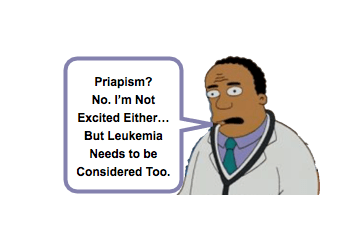Originally published at Pediatric EM Morsels on July 27, 2018. Reposted with permission.
Follow Dr. Sean M. Fox on twitter @PedEMMorsels
The vast majority of the time, caring for patients, particularly children, is extremely rewarding and life affirming. We are among the few who are privileged to make a true positive impact on a person’s life. There are times, however, when the specifics of an encounter can make the job less than appealing, although, important nonetheless. One specific condition that may lead to a less than enjoyable shift is priapism. Why? Well, the procedure is not one people typically thank you for doing afterwards, even if successful. In addition, like Fever of Unknown Origin, it may also lead to a tough conversation about oncologic conditions. Let’s take a minute to review Priapism in Children:
Priapism: Basic
- Priapism is prolonged penile erection without sexual stimulation. [McGrath, 2011]
- Priapism is caused by an imbalance of penile blood inflow and outflow.
- Priapism is classified into two categories:
- Low-Flow / Ischemic
- Most common type
- Usually related to poor venous blood flow out of the penis
- TRUE Emergency
- Essentially compartment syndrome of the penis
- Little or no intracorporal blood flow (hence “low-flow”)
- Characteristics: [Hazra, 2013]
- Painful
- Rigid penis
- Blood sample results:
- Low pH (< 7.25)
- Hypercarbia (> 60 mmHg; some references say > 90)
- Hypoxia (< 30 mmHg)
- Most common type
- High-Flow / Non-ischemic
- Usually related to trauma
- Increased arterial inflow overwhelms venous outflow. [Hazra, 2013]
- Less worrisome acutely as there is continued arterial blood flow
- Characteristics: [Hazra, 2013]
- Can be painless
- Penis is not completely rigid
- Blood sample results:
- Normal pH (> 7.40)
- Normal CO2 (< 40 mmHg)
- Normal O2 levels (> 90 mmHg)
- BRIGHT RED Oxygenated Blood
- 3rd type Described as “Recurring” or “Stuttering” [Park, 2015]
- Variant of ischemic priapism
- More likely in patients with sickle cell disease.
- Low-Flow / Ischemic
- Prolonged or recurrent priapism is associated with: [McGrath, 2011]
- Sexual dysfunction
- Cosmetic abnormalities (from fibrosis)
Priapism: Considerations for Children
- Low-Flow Priapism [Jacobs, 2015; Hazra, 2013]
- Sickle Cell Disease
- Most common discovered cause (>60%) in children [Park, 2015]
- Leukemia
- May be the first manifestation of a leukemia, although rare [Hazra, 2013]
- Accounts for ~15% of priapism cases in children
- Chronic myeloid leukemia is most common oncologic cause
- Acute myeloblastic and lymphoblastic leukemia also noted as causes
- Likely related to hyper-leukocytosis leading to slow flow from leukemic cell aggregation.
- Can also lead to central nerve system infiltration and subsequent sacral nerve dysfunction.
- May be the first manifestation of a leukemia, although rare [Hazra, 2013]
- Adverse Drug Reactions
- Antidepressants [Park, 2015]
- Trazodone
- SSRIs
- TCAs
- Antipsychotics
- Risperidone
- Phenothiazines
- Anticoagulants
- Antihypertensives
- Illicit substances (ex, cocaine, marijuana)
- Antidepressants [Park, 2015]
- Hypercoagulable States
- Mycoplasma pneumoniae infection has been reported [Jacobs, 2015]
- Sickle Cell Disease
- High-Flow Priapism [Jacobs, 2015; Hazra, 2013]
- Severe, blunt, perineal Trauma, but… may also be less “noticeable” trauma [De Rose, 2017]
- Can present in delayed fashion (24-48 hours after trauma)
- Often initiated by sexual stimulation.
- Recent procedure may injure dorsal vessels. [Granieri,2016]
- Severe, blunt, perineal Trauma, but… may also be less “noticeable” trauma [De Rose, 2017]
- Delays in seeking care may occur and lead to increased complication risk:
- Embarrassment may cause child to avoid informing anyone
- High-Flow priapism may be less painful, so more easily avoided.
Priapism: Management
- History and Physical (goes without saying)
- New meds?
- History of Sickle Cell Disease
- Unexplained fevers or weight loss?
- Prior episodes of priapism
- Labs:
- CBC with differential
- Especially for Sickle Cell disease or if concern for leukemia
- Corporal Blood Gas Sample
- A blood aspirated from the corpus cavernous can be placed in a heparinized syringe and sent for analysis. [McGrath, 2011]
- Helps discern high-flow from low-flow.
- High-Flow (non-ischemic) priapism generally resolves spontaneously and rarely requires intervention. [McGrath, 2011]
- CBC with differential
- Pain management:
- Consider dorsal penile nerve block
- Parenteral analgesics and sedatives may be needed
- Interestingly, some reports of Ketamine being effective at relieving low-flow priapism [Park, 2015]
- May be property of the medication, or may be effect of dissociative sedation.
- Interestingly, some reports of Ketamine being effective at relieving low-flow priapism [Park, 2015]
- Treat possible underlying etiology
- ex: Sickle Cell Disease may benefit from:
- Hydration
- Blood Transfusion (to increase portion of Adult vs Sickle Hemoglobin)
- Plasmapheresis
- ex: Sickle Cell Disease may benefit from:
- Corpus Cavernous Aspiration
- Some (~30%) will only require reduction of pressure from simple aspiration. [McGrath, 2011]
- Send the sample for blood gas testing
- Use 19 to 21 gauge needle / butterfly needle or angiocatheter
- (See EMin5 on YouTube)
- Instillation of alpha sympathomimetic
- Phenylephrine is a pure alpha agent
- Instill 1 mL of dilute phenylephrine (100-500 micrograms per milliliter of normal saline) into the corpus cavernous. [McGrath, 2011]
- Smaller volumes may need to be used for younger children.
- Call Some Friends
- Even if you are successful at resolving the priapism.
- Consult Urology
- May require surgical options (ex, Shunts) if unsuccessful.
- Consult Hematology for those with Sickle Cell Disease or concern for oncologic process.
Moral of the Morsel
- History is important! It may help you discern the cause as well as the type of priapism.
- Pain control is also important! Consider ketamine … like always!
- It isn’t all due to sickle cell disease. Is it Leukemia?









